Updated on August 19, 2022
Are you the type of person that goes to watch birds in nature during the day and night? Then, you need the best monocular for bird watching with you. Not only does it help you catch amazing views of known and not-so-well-known species, but it also provides multiple options for recording them and transferring the materials on external devices.
The only trouble here is that this year, there are many brands and models on the market. All of them have something special and interesting to offer, which is why potential buyers can get confused. Still, when it comes to bird watching, some features are more useful than the rest.
To assist you with discovering which they are, in the following paragraphs we’ll go over the important details. So, let’s start!
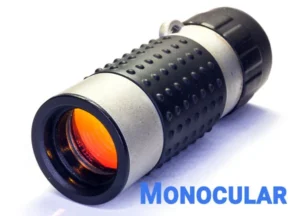
Top 3 Picks: Best Monocular for Bird Watching
BEST VALUE
Bestguarder 6×50 Night Vision Monocular

BEST OVERALL
BOBLOV P4 Night Vision Monocular
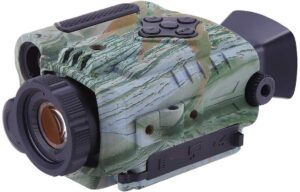
BEST PRICE
Vortex Optics Solo Monocular

The 15 Best Monoculars for Bird Watching
In general, bird watching requires gear that can provide details in nice clarity and sharpness. As many birds are smaller, the chosen monocular should be able to detect them from a fair distance even if they are hiding in the trees. Therefore, you should be aware of this when looking at the numerous models that are offered on the market.
Don’t worry since the features they possess will show you whether they match your needs. Here we point out some of the best ones out there.

Bestguarder 6×50 Night Vision Monocular
No matter if you want to watch birds during the day or night, this monocular makes this possible. It has many options for detecting different types of birds at varying distances. With the viewfinder that’s digital and the built-in illuminator, it can make the surroundings brighter and clearer.
Aside from this, lovers of birds will rejoice at the fact that they can record videos and take pictures, which they can later share through other devices, including smartphones and tablets. Not to mention that since the model is durable, it can be utilized when the weather is changing.
The biggest downside that users associate with it, though, is the size. So, those that are looking for smaller monoculars that occupy less space should take this fact into consideration when making their final choice.
Looking to read more reviews? Check the Best Gen 2 Night Vision Monocular.

Vortex Optics Solo Monocular 8×36
This one is among the top choices of people that want compact models by their side. The Vortex Solo monocular can be carried in the pocket. Its non-slippery design enables users to utilize it comfortably for long periods of time. Because it has multi-coated lenses, the transmission of light is improved and the views viewers get are bright and clear.
However, the small size and weight don’t mean that the monocular isn’t durable at all. In fact, it is made to resist water and fog. And if any damage befalls it by any means, there is a special lifetime warranty coming with it. Another thing that’s worth mentioning is that it operates well when the light is low, as well.
But what people find as an issue with it is that it lacks caps for the lens. Also, the focus ring apparently was tough to turn and required two hands.
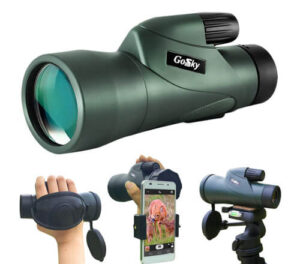
Gosky 12×55 High Definition Monocular
The detail that separates this monocular from many others is the large magnification. This means that users can zoom in many times and discover the various species of birds lurking in their surroundings. Because of this, it isn’t the most lightweight one, but it’s not too heavy either.
What comes in handy to many observers is the fact that it can be paired with a smartphone and you can watch the images through there. They can even be kept for later usage. Also, it can be mounted on a tripod for steady views without interruptions.
Still, it isn’t considered very stable without a tripod and the size can be a burden for many users that plan to carry it during long trips.

Emarth High Power 10-30×50 Zoom Monocular
Firstly, this is a monocular that offers lenses with a large diameter and a BaK-4 prism for clear images. Those that use it shouldn’t worry about damaging it as there is a lifetime warranty in case anything goes wrong. And to protect it from harsh conditions, the manufacturer built it to be waterproof and fog proof.
Leaving this aside, the monocular is suitable for people that wear glasses, too. This is thanks to the long eye relief that it possesses. But it doesn’t provide a way to attach a strap for easier carrying and there are reported issues with the tripod mount.
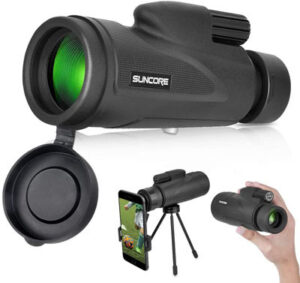
Evershop Monocular Low Light Vision
Both adults and children can utilize this monocular for watching birds in nature. Generally, it’s simple to use and it has a tough rubber armor that contributes to its durability. Moreover, it can resist shock, water, and other similar conditions.
Another useful detail is that it’s lightweight, so people can carry it everywhere with ease. And the option to mount it on a tripod and connect it to a phone makes it even more convenient for various situations. Yet it should be noted that the connection with a smartphone apparently requires a longer time to set up.
Eventually, the opinions are split when it comes to the performance in low light conditions. While this is a good thing, a possible con that users report is the fact that it’s not as efficient when it’s completely dark.
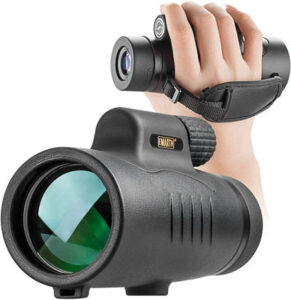
Feemic Monocular Telescope
This monocular has many helpful features that make the bird watching experience pleasant. For starters, its lens is completely multi-coated with a BaK-4 prism for increased quality of the views and light transmittance. These explain the sharp and clear images that people get.
When it comes to the size, it’s relatively small and compact, making it simple to hold in your hand. Related to this, the finish made of rubber contributes to the comfort it provides. Not to mention that the materials of the armor are able to withstand the changing and harsh weather.
But it should be noted that a tripod is not included with the device even though it possesses a connector on the bottom. Also, magnification tends to be small for some users.
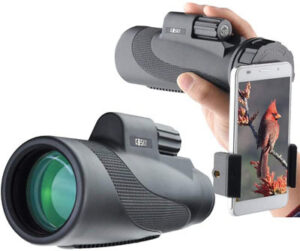
Gosky Titan 12×50 High Power Prism Monocular
Gosky’s Titan is certainly one of the most durable models out there. Among everything else, this is an important asset to bird watchers. It’s powerful with the large magnification, multi-coated lens, and the BaK-4 prism that are responsible for the bright views and the clarity.
While the armor made of rubber increases the comfort and makes it more controllable, due to the big zoom the views can appear shaky, though. Still, the truth is that high-quality materials are included in the monocular and it is sealed to stop water, dust, fog, moisture, and others from entering and causing any damage. Thanks to this, it can be utilized for a long time.
Finally, there is an option to connect it to an external device like a smartphone, for instance, and view the images through there.
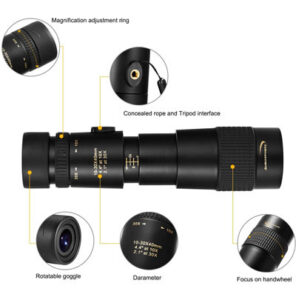
Aurosports 10-30×40 Zoom Monocular
Although some buyers think that monoculars with low prices don’t possess premium features, this one proves them wrong. With its high-definition green and blue film and BaK-4 prism, it’s able to produce clear and bright views at various distances.
Not to mention that it’s compact and can be taken everywhere. This comes in handy to those that plan to watch birds in nature for long periods of time. A note in this regard is that the manufacturer advises not to leave the monocular in deep water. It’s waterproof but to an extent.
Another possible downside that was reported is that it’s not very simple to focus.

BOBLOV P4 Night Vision Monocular
Actually, Boblov’s monocular can be utilized for many different activities, including observing birds both during the day and night. It has a built-in infrared illuminator that expands the viewing area in low light.
Among the features that make it useful to viewers is the option to record videos and take photos, which can then be stored on the SD card or shared through external devices. That way more people can access them and relive some notable moments from their trip. Connected to this, it’s powered by batteries that are removable, sparing users from additional costs and making sure they don’t run out of power in the middle of nowhere.
To make it more stable, users can attach it to a tripod or mount it on a helmet. The small and lightweight design makes this possible. Despite this, it should be mentioned that users report some downsides that have to do with the charger and batteries not being included and the high price.
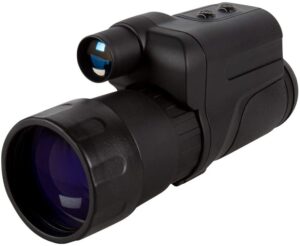
Firefield Nightfall Night Vision Monocular
There are many beautiful nocturnal birds out there that are worth seeing and even recording or capturing in a photo. That’s why a night vision monocular like this one is a nice companion in these situations. Firefield Nightfall is known for its electro system for the optics that amplifies the light that’s already there. But it can operate in complete darkness, as well.
In terms of the quality of the views, it incorporates an infrared illuminator for brightening the surroundings. For easier focusing, the diopter of the objective lens and the eyepiece can be adjusted by rotating.
Aside from this, users can expect to get rugged waterproof housing that’s durable. Thanks to this, it can withstand harsh conditions that may befall you on your journey. And all options are quickly accessible with the press of a button.
However, people say that they presumably experienced difficulties with the views appearing fuzzy around the edges and the fact that the batteries aren’t included.
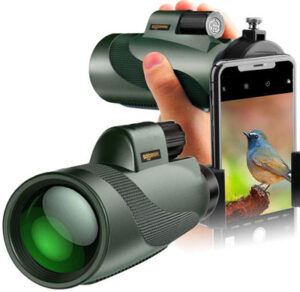
SOLOMARK 12×50 High Power Monocular
Beginning with its construction, this SOLOMARK model doesn’t lack in the strength and durability departments. To make it waterproof and resistant to any dust particles as well as debris from entering, the manufacturer nitrogen-purged the monocular and O-sealed it, too. The sturdiness is leveled up with the rubberized armoring.
Furthermore, the lens is multi-coated. The prism is of the BaK-4 type. Another plus is the great eye relief. That means that users can wear glasses while they watch birds with this monocular and have no trouble with the viewing experience.
On the other side, the model is a bit bulkier and larger when compared to similar ones.

VIVREAL 12×50 High Power HD Monocular for Bird Watching
With a BaK-4 prism and full multi-coatings, this monocular easily delivers clear and detailed visuals. It’s known for a great percentage of light transmittance, too. Additionally, users can zoom in plenty on the birds they’re observing and can also see plenty of the surroundings.
The ergonomic design enables swift and easy modifications. The rubberized armoring and the waterproof capabilities make the model exceedingly long-lasting.
Some of the things that can be improved are related to the accessories provided by the manufacturer. A few customers thought that the strap is a bit small to be a neck strap and the soft carrying bag was too small to accommodate something other than the monocular itself.
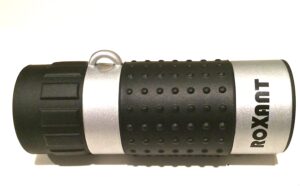
Roxant High Definition Ultra-Light Mini Monocular
Something that helps this model stand out is how compact it is. That’s why some even say that it’s pocked-sized. Even though that is the case, the model still packs some serious features like great transmittance of light as well as multiple coatings, to name just a few. What’s more, the exterior ensures a tight yet comfortable grip on the monocular, so it doesn’t slip and fall easily.
It’s very affordable, so users should expect to get the features and the overall quality that matches this price. Subsequently, some users weren’t great fans of the magnification capabilities.
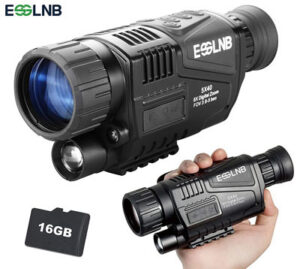
ESSLNB Night Vision Monocular
The model sports a rubber armoring with stripes for a no-slip grip and increased durability. Further, it’s nitrogen-filled as well as sealed to prevent any dust or debris from entering the monocular’s internal system and damaging the lens. With that, it resists water and fog, too.
Besides night observation, users can use this model during the day as well as in low-light conditions. Thanks to its magnification abilities as well as its digital zoom, they can see plenty of the subject from a distance.
Another useful feature is the capturing of images and videos. These visual materials can be stored and later shared on other devices. What’s more, the monocular can be mounted on a tripod, as well.
According to a handful of customers, the buttons can be more user-friendly.

BNISE 8×40 Infrared Night Vision Monocular
Users can take this monocular for bird watching during the daytime, nighttime, as well as in low-light surroundings. An IR illuminator, which is easy to modify, makes this possible. And users can see plenty in these conditions thanks to the size of the lens as well as the digital zoom and the magnification.
They can have proof of what they’ve seen in the form of images and videos that the monocular can take for you. These can be transferred with a USB cable and with it the monocular can be connected with a computer.
Together with the purchase, buyers get all the basic accessories that are provided by the brand, including a battery among other things.
On the other hand, some have pointed out that the battery life is a bit shorter when compared to a similar model in that range.
The Buyer’s Guide to the Top Quality Monoculars
Just like with purchasing every other product, it comes naturally to you to become aware of its features. So, this is the part where we’ll outline some of the most significant features and specifications that can determine the model’s entire performance. Since we’re talking about the best monocular for bird watching, these models need to have slightly different features to successfully execute the task and deliver effective results.
Size
Considering that monoculars are smaller when compared to binoculars, users can easily utilize them by holding them with a single hand. To be able to achieve that, they should be extra compact and not strain the muscles in the hand and the arm.
Moreover, buyers should check out the model’s description as well as the manual provided by the manufacturer for this type of information. With this, you’ll be able to compare the model’s exact dimensions with your expectations and decide if it’s adequate for your needs.
The usual tip provided by professionals is to look for compact models if you plan to take a lot of things with you when you’ll be out bird watching. That’s because a bigger monocular will additionally burden you and slow you down. On the other hand, it’s considered that slightly bigger monoculars tend to deliver clearer visuals. In that case, don’t hesitate to purchase a model that’s a couple of inches bigger than expected.
Construction
By this, we refer to how the monocular is made and the types of material that are used in its production. High-quality materials can make the model resistant to harsh weather conditions.
With that being said, it’s always desirable to look for models that are waterproof, fog proof, and prevent any particles of dust and debris from entering the monocular and damaging the lens system. However, even if you find and purchase a model with these capabilities, you should still be very careful. That’s because monoculars typically have different levels of such protection against extreme external conditions. So, you may think twice about using them in such conditions.
Furthermore, a solid construction makes the monocular long-lasting. That may include anti-slip design that prevents the model from slipping and falling easily and ensures a stronger grip. Also, quality materials make the model resistant to shocks and impacts so that it doesn’t break apart easily.
One of the most frequently used materials for the external armoring is rubber. Plus, it makes the monocular look good, too.
Cost
Naturally, if you’re browsing for monoculars for children or if you’re just getting introduced to bird watching, then buying the most expensive model doesn’t sound like a good idea. On the other hand, if you’re a professional, you shouldn’t feel bad for spending extra bucks on a monocular.
Usually, monoculars are divided into a couple of price tiers. Generally, you can find decent models from a price of fifty dollars or below to three hundred dollars and more.
As we mentioned, the cheapest options can be found at a price of fifty bucks or less. They tend to be durable and have satisfactory performance. On the other hand, you may be limited to the magnification department.
The most expensive models have a price tag of something north of a hundred and fifty dollars. They’re the most durable and present the user clear and crisp visuals. However, because of their price you need to consider again if you need only a pricey model like that to do the job.
Magnification Powers
The magnification capabilities take the central stage in none other than monoculars for bird watching. That’s because users typically observe birds at a distance as some are easily scared. Thanks to the magnification, users can zoom in on a bird and take a good look at all details.
When it comes to bird watching, experts suggest a magnification that ranges from eight times to twelve times. For instance, too much magnification powers will make the visuals increasingly unsteady and shaky. And you’ll most likely need a tripod to take pictures. But that isn’t usual in the range we wrote about.
Objective Lens Size
Together with the magnification, the objective lens diameter is usually indicated in the name of the monocular, itself. So, after a thorough analysis, the size of a monocular’s lens can be anything between twenty-five millimeters and seventy millimeters. The former is found in compact monoculars, whereas the other is a common component of larger models.
Opting for something between the two options is great for portable models. What’s more, an objective lens that’s smaller than twenty-five millimeters and even smaller than thirty millimeters won’t give as satisfying results when used for bird watching when compared with others.
Eye Relief
Even people who wear eyeglasses and enjoy bird watching can join the fun with a monocular. For these people, the eye relief plays a vital role.
First, to define it, it represents the distance from the person’s eyes and the eyepiece of the monocular that enables the user to see the complete visual without losing some part of the visual.
With that being said, a shorter eye relief won’t enable users to do so and users who wear glasses usually go with models that have a larger eye relief. Some experts suggest an eye relief of around fourteen millimeters. Tough, it would be better if you somehow have a chance to try out the monocular and see if it works great even with glasses on.
Field of View (FOV)
The field of view of the monocular determines how much you can see of the scene before you. As a feature, it’s usually measured in feet as well as yards.
Having in mind that birds are very movable and swift, you will benefit more from a larger field of view. Some recommend two hundred feet at a thousand yards as a minimum in these cases.
Another thing that users should be aware of is the trade-off between the field of view and the monocular’s magnification. Moreover, when you zoom in, the field of view decreases, and vice versa.
Frequently Asked Questions (FAQs)
1) What are some of the accessories that usually come with a monocular for bird watching?
Answer: While you don’t necessarily need accessories for the monocular to function properly, they represent a great addition that enhances its performance.
Some accessories are typically gained with the purchase. On the other hand, some are sold separately and you can check them out based on the task you’re about to perform as well as your needs. In most cases, the manufacturer provides you a carrying bag for the monocular as well as a cloth for the lens, maybe some lens covers, and similar.
To make the entire viewing experience better, some users opt for buying a tripod. Mounting your monocular on a tripod will steady the visuals and enable you to use the monocular for a long period without straining your hand. Another accessory that users can purchase is a smartphone holder. With it, you can connect your phone with your monocular and make the latter more versatile.
2) How can I clean and maintain my monocular for bird watching?
Answer: Even though the cleaning process may take you a while, it’s going to be easy and efficient once you get used to it. Begin with a microfiber cloth and wipe away any fingerprints that may lie on the exterior and the lens. Make sure that the cloth is dry and clean. With a brush that is specifically made for the lens, slowly remove any dust or debris on the lens that diminishes the quality of the visuals. Also, if you think that the monocular is especially dirty, you may consider using a cleaning solution or asking help from a professional.
When it comes to the maintenance part, it encompasses general care from your side both while you’re utilizing the monocular and when you aren’t. When you don’t use it, store it in an adequate place that is dry and cold. Further, use a carrying bag or similar for transportation and carrying around.
3) What can I use my monocular for besides for bird watching?
Answer: The best monocular for bird watching can be utilized for many activities and on many occasions aside from their original purpose. That’s why they’re considered to be among the most versatile category of monoculars. Since you can see objects from a distance with them, you can use them both outside and indoors. For instance, some of the uses may include observing what lies ahead when hiking, looking at target and game when hunting, looking in the distance while camping, and more.
4) Is a monocular better than binoculars for bird watching?
Answer: Generally, this boils down to the personal preferences and tastes of the individual user. There is no rule that is set in stone regarding this. Many people point out that monoculars can be the right choice for the task. That’s because they’re smaller and lighter, and thus more compact. This makes them easier for holding and transporting.
Final words
A monocular is such a versatile tool that users can utilize it for numerous activities among which is bird watching. This is easily achievable because monoculars have just a single barrel, unlike binoculars. Plus, their design is more compact and made for holding in one hand. Yet, this doesn’t limit the monoculars for birding when it comes to great performance. The visuals they present to the users are still clear and crisp. Of course, the quality still depends on the quality of the model.
With that being said, one last thing before you set off to purchase the right monocular for you, consider a few things. The two most important factors are usually your needs and your budget. Try your best to match your present needs or tasks you have in mind with the model. If you’re a newcomer to using monoculars, extra complicated features of high-end monoculars may confuse you even more. Also, make sure you have a pre-determined budget in your head. This will increasingly help you navigate the monocular market and get the most out of a deal.
So, what do you think of monoculars for birding? Do you have experience with them or are you looking into buying one for the first time? We’re eager to hear your opinion!

